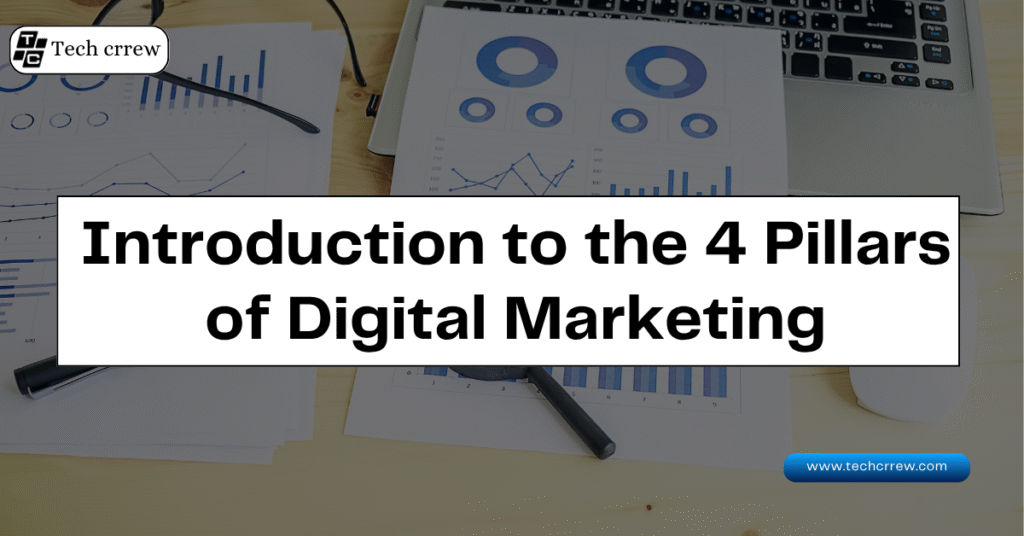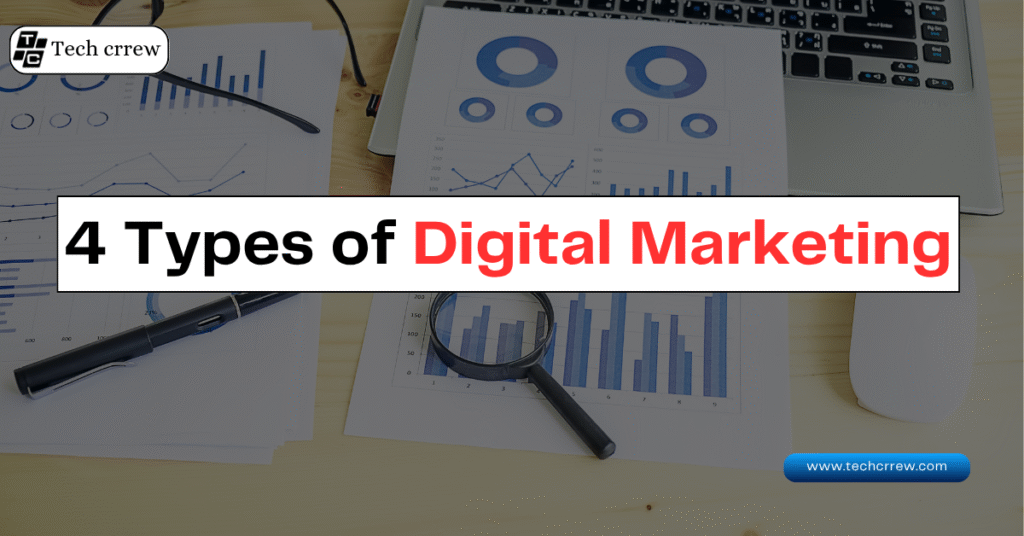In our fast-paced, interconnected world, digital marketing has become the lifeblood of successful brands and flourishing businesses. As more consumers turn to online platforms to make their purchasing decisions, grasping the key types of digital marketing is crucial for any company looking to broaden its reach, establish brand authority, and maximize return on investment (ROI).
So, what are the four types of digital marketing that every business should weave into their strategy? This article will take a closer look at each one: Content Marketing, Search Engine Optimization (SEO), Social Media Marketing (SMM), and Pay-Per-Click (PPC) Advertising. Throughout this journey, you’ll discover how these strategies work in harmony and why Tech Crrew is your go-to partner for top-notch digital marketing services.
Table of Contents
- Introduction to the 4 Pillars of Digital Marketing
- What Should Be Included in Content Marketing?
- What Should Be Included in Search Engine Optimization (SEO)?
- What Should Be Included in Social Media Marketing (SMM)?
- What Should Be Included in Pay-Per-Click (PPC) Advertising?
- Why You Need a Multi-Pronged Digital Marketing Strategy
- Ready to Grow? Hire Tech Crrew for Digital Marketing Excellence
Introduction to the 4 Pillars of Digital Marketing

Digital marketing involves promoting products or services through online platforms, tools, and strategies to connect with targeted audiences, enhance visibility, and drive conversions. While there are many branches, the four core types are
- Content Marketing
- Search Engine Optimization (SEO)
- Social Media Marketing (SMM)
- Pay-Per-Click (PPC) Advertising
By understanding and integrating these strategies, you can amplify your online presence and fuel business growth.
What Should Be Included in Content Marketing?
Content marketing revolves around crafting and sharing valuable materials—think articles, videos, infographics, and podcasts—that aim to inform, engage, and ultimately convert your audience.
Key Elements of a Strong Content Marketing Plan
- Content Creation: Consistently producing blogs, videos, white papers, or eBooks that cater to your audience’s interests.
- Content Distribution: Spreading your content across your website, email newsletters, and various third-party platforms.
- Audience Engagement: Fostering interaction through comments, shares, and direct messages.
- SEO Optimization: Structuring your content with the right keywords and topics that your ideal customers are searching for.
- Content Strategy & Calendar: Planning your content releases to align with different stages of the buyer’s journey—awareness, consideration, and decision-making.
- Performance Analysis: Utilizing analytics to gauge engagement, conversion rates, and ROI, and refining future content based on these insights.
Content marketing builds trust, educates customers, and gently guides them toward making purchase decisions by consistently delivering relevant information at just the right moment.
What Should Be Included in Search Engine Optimization (SEO)?
Search Engine Optimization (SEO) is all about enhancing your website and its content to achieve higher rankings on search engines like Google, thereby attracting organic (free) traffic.
Core Components of a Successful SEO Strategy
- Keyword Research: Discovering and targeting the search terms that your potential customers are using.
- On-Page SEO: Fine-tuning your content, titles, meta descriptions, and headers with relevant keywords.
- Technical SEO: Improving site structure, mobile responsiveness, speed, and schema markup.
- Off-Page SEO: Building backlinks from reputable sites, participating in guest blog posts, and engaging in social sharing.
- Content Quality: Publishing high-value, well-structured, and original content that aligns with user intent.
- Monitoring & Adjustment: Regularly tracking search performance and making data-driven tweaks to improve results.
SEO is crucial for achieving lasting growth in the digital marketing landscape, ensuring your business stands out when potential customers are on the hunt for the solutions you offer.
What Should Be Included in Social Media Marketing (SMM)?
Social Media Marketing (SMM) leverages platforms like Facebook, Instagram, X (formerly Twitter), LinkedIn, and TikTok to boost brand visibility, engage with audiences, and create a sense of community.
Best Practices for SMM Success
- Goal Setting: Clearly defining what you want to achieve—whether it’s raising brand awareness, generating leads, or enhancing customer service.
- Audience Research: Getting to know your audience’s demographics and figuring out what type of content resonates with them.
- Consistent Branding: Ensuring your visuals and messaging reflect your brand identity across all platforms.
- Engaging Content: Sharing a diverse mix of articles, videos, polls, and content created by users.
- Paid Advertising: Running targeted ads to connect with specific audience segments and encourage action.
- Analytics & Iteration: Keeping an eye on engagement rates, reach, and conversions, and regularly fine-tuning your strategy.
SMM enables real-time interactions with customers, boosts your visibility, and is budget-friendly—making it a vital component of any digital marketing plan.
What Should Be Included in Pay-Per-Click (PPC) Advertising?
Pay-Per-Click (PPC) Advertising allows you to display ads on platforms like Google Ads, Bing, Facebook, and Instagram, charging you only when someone clicks on your ad.
Building Winning PPC Campaigns
- Keyword Selection: Identifying high-intent keywords that are relevant to your products or services.
- Ad Creation: Developing eye-catching headlines, engaging descriptions, and appealing visual content.
- Audience Targeting: Segmenting your audience based on demographics, interests, location, or even the time of day.
- Budget Management: Setting daily or monthly spending limits and adjusting bids to maximize your return on investment.
- Landing Pages: Creating effective landing pages that align with your ads and boost conversion rates.
- Performance Analysis: Monitoring clicks, costs, and conversions and continuously optimizing your campaigns.
Why You Should Embrace a Multi-Faceted Digital Marketing Strategy
Sticking to just one form of digital marketing can really hold back your reach and growth. By combining Content Marketing, SEO, SMM, and PPC, you can tap into some fantastic benefits, including
- A wider audience reach
- Quicker growth and increased visibility
- Varied streams for lead generation
- Enhanced customer engagement and loyalty
- Decisions backed by data
Experts agree that adopting a multi-channel digital marketing strategy is crucial for making a significant impact and staying resilient in today’s ever-evolving landscape.
Ready to Take Off? Partner with Tech Crrew for Digital Marketing Excellence
Whether it’s improving your search rankings, crafting viral social media posts, or fine-tuning your paid ads, Tech Crrew is here to be your go-to partner for all things digital marketing. Our team uses tried-and-true strategies in content creation, SEO, SMM, and PPC, all customized to meet your business’s specific goals.
Elevate your business—reach out to Tech Crrew today for a complimentary digital marketing consultation, and let’s create your online success story together!

